|
SETMA has had a Diabetes Prevention Program for over 14 years, but while excellence in the treatment of diabetes is the mission of SETMA’s diabetes treatment program, because we also see thousands of patients who are not diagnosed with diabetes and because there are millions of Americans who have diabetes and don't know it, we must be vigilant to recognize those who do have undiagnosed diabetes. And, we must be attentive to those patents who should be screened for diabetes; to those who are at high risk of developing diabetes, and particularly to those who have pre-diabetes.
It would be tragic, we think, to be giving excellent care to patients diagnosed with diabetes and to be seeing patients who have diabetes and not be giving them excellent care because we did not make the diagnose. As a result, SETMA continually renews our commitment to screen our patients appropriately for diabetes, to identify those who are at risk of diabetes and to make every attempt to help our patients who are at risk avoid progressing to full-blown diabetes.
The Steps of SETMA's Diabetes Prevention Program (DPP)
The first step in the screening for and the preventing of diabetes is to always have it in the forefront of our attention as wee see all patients in the clinic, the nursing home, the hospital or other sites. SETMA does this through our electronic health record.
All providers start seeing a patient from what we refer to as the AAA Home template. This template lists all of our electronic patient management tools and alerts healthcare providers and nurses to those tools which need to be reviewed and completed for each patient. .
At the top of AAA Home is the Pre-Visit/Preventive Screening Template. When that template is opened, the following appears.
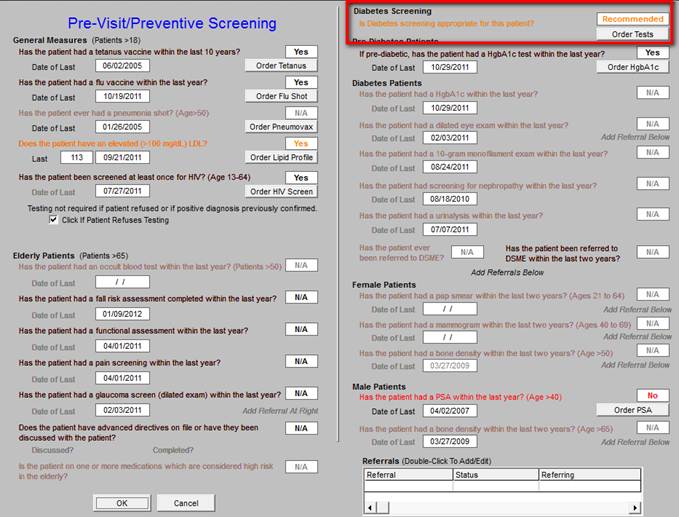
Outlined in red, you will see the Diabetes Screening, which alerts the provider and nurse to the fact that a patient needs diabetes screening and it has been done, or that the patient needs screening and it has not been done.
As you can see on AAA Home which is displayed below, the second tool listed under "Preventive Care" is entitled "Preventing Diabetes." When the patient being seen meets the criteria for needing screening for diabetes, the title "Preventing Diabetes" will be displayed in red.
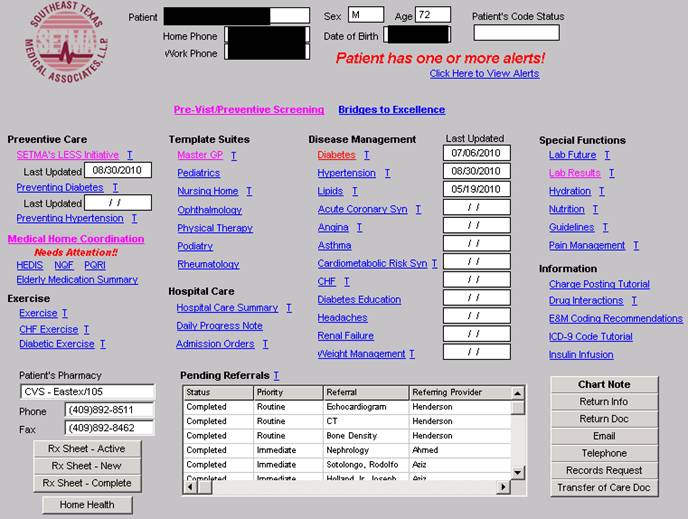
It must be remembered that there are not only two categories of patients in regard to diabetes, i.e., those who have it and those who do not, but there are two other categories. There are patients who are at high risk of diabetes and there are patients who have already been designated as having pre-diabetes. Pre-diabetes is a condition where a patient has progressed to a point where their ability to handle blood sugar is affected negatively and to where they have an increased risk of heart disease and other complications, which, while not as severe as a patient who has diabetes, is more severe than a person who is simply at higher risk for the development of diabetes.
SETMA’s DPP mission is to identify these groups:
- Patients who have diabetes
- Patients who don't have diabetes
- Patients who are at high risk for diabetes
- Patients who have pre-diabetes
- Patients who, while they are not at high-risk and/or who do not have pre-diabetes, nevertheless are of an age or condition that they should be screened for diabetes.
In this context, when a healthcare provider "clicks on" the "Preventing Diabetes" title, the following template is deployed.
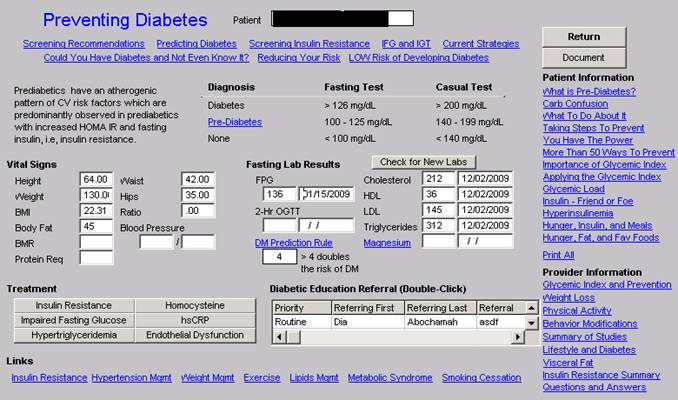
While this template appears busy, it contains a wealth of information which is valuable to a patient’s health. The following is a description of its content:
- Across the top are eight tools which are described below.
- Next there are the definitions of diabetes and of pre-diabetes. These are the standards of diagnoses which your provider will use in evaluating your status. One new standard will be added and that is if your hemoglobin A1C is 6.5% or greater on two occasions, you also have diabetes. The following is a brief summary of how diabetes is diagnosed:
- A patient has fasting blood glucose of 126 mg/dl on two separate occasions.
- A patient has a random blood glucose of 200 mg/dl or higher
- A patient has a 2-hour Glucose Tolerance Test with a two-hour blood glucose value of 200 or greater.
- A patient has a HgbA1C of 6.5% or higher on two different days.
- A patient’s vital signs, fasting lab results and cholesterol results. The reason for this is that blood pressure and cholesterol are critical parts of the treatment of diabetes, pre-diabetes and those who are at high risk of the development of diabetes.
- Treatment of conditions associated with pre-diabetes, diabetes and those at high risk of the development of diabetes.
- Links to other patient management tools which will be used in SETMA's DPP.
- Down the right-hand side of the template are a series of education pieces which the provider can give to patients, which will help them manage their health. Patients are encouraged to ask their provider to print these materials.
The first tool listed at the top of this screen is entitled "Screening Recommendations." When the tool is deployed it is entitled "Recommendations to Delay or Prevent Diabetes."
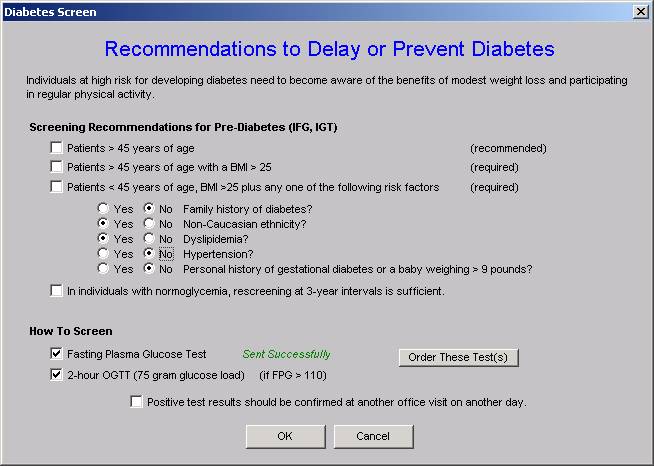
When deployed this tool automatically assesses whether screening for diabetes is "recommended" or "required." The healthcare provider does not have to "look up" this information. The electronic health record automatically collects the results from structured fields" in the record and alerts the provider to check whether or a patient needs screening. This is the same material on the basis of which the "Preventing Diabetes" button on AAA Home is turned red or not.
If a patient requires screening, the provider will click the button entitled "Order These Tests." At that point a message will appear asking if the patient has been fasting for twelve hours. If the patient has, the Fasting Plasma Glucose can be ordered at that time.
If the Fasting plasma glucose is between 100 and 125, the patient will be diagnosed with "Impaired Fasting Glucose". This is a Pre-diabetes condition and it is a more serious condition than simply having an increased risk of diabetes and requires immediate and persistent steps in order to delay the onset or to prevent the onset of diabetes.
If the 2-hour result of the 2-hour Glucose tolerance test is between 140 and 199, the patient will be diagnosed with "Impaired Glucose tolerance". This is also a Pre-diabetes condition and it is even more serious than Impaired Fasting Glucose. It should result in immediate and serious alterations of life style in order to delay or prevent the onset of diabetes. Those steps are weight reduction, dietary counseling and modification and a regular, consistent exercise program. Also, control of cholesterol and blood pressure should be achieved and maintained.
Predicting the Development of Diabetes in Older Adults
If a patient is over 65 years of age, this tool allows the provider to estimate the risk of the development of diabetes without first doing a 2-hour Glucose Tolerance Test. The details of this tool can be read on the template. Again, the content is automatically displayed. If the score is above 4, the patient is at higher risk of developing diabetes and preventive steps should be taken.
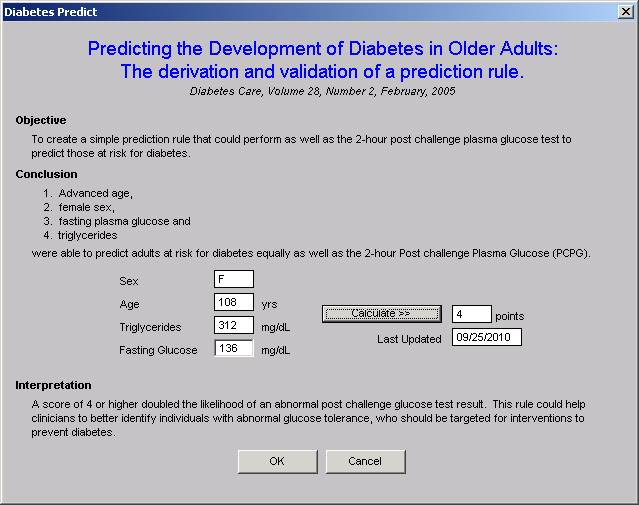
And, if the patient’s result is 4 or over, the provider may want to order a 2-hour GTT, although new standards allow diabetes to be diagnoses on the basis of non-fasting hemoglobin A1c results.
IFG and IGT
One of SETMA's guides for developing electronic patient management tools is to display all of the information a provider needs in order to provide excellent care to a patient. This is based on our desire to make sure that a provider has access not just to what he/she knows but to what is known about a condition. And, it is based on the principle that what all a person absolutely must remember, is often forget, but that which a person does not have to remember, is rarely forget. Therefore, we try to make all that a provider needs to know available in the electronic health record, which means that he/she will rarely if ever forget that which is important.
The definitions of Impaired Fasting Glucose (IFG) and of Impaired Glucose Tolerance (IGT) are critical to the diagnosis of Pre-diabetes and to the prevention of diabetes, thus we display them. SETMA providers don't have to remember them, therefore, they always do. The definitions of IFG and IGT and important ideas about both are presented on this template.
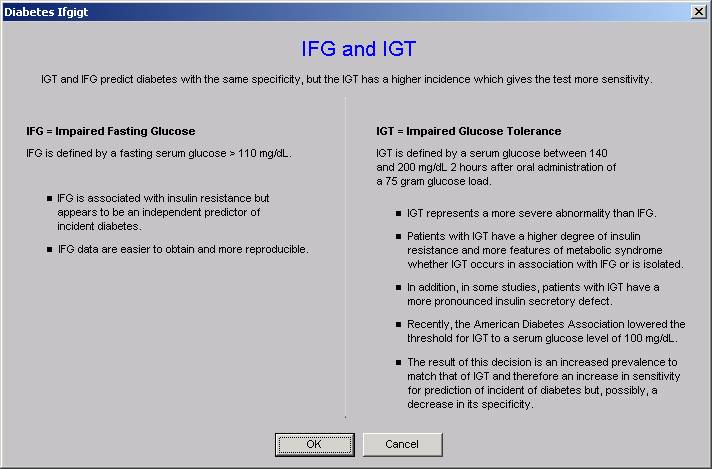
Could you have diabetes and not even know it?
With the single click of a button, the SETMA healthcare provider or nurse can give a patient a numerical summary of their risk of developing diabetes. If the patient is at high risk, the patient can take steps to avoid diabetes or at least delay its onset.
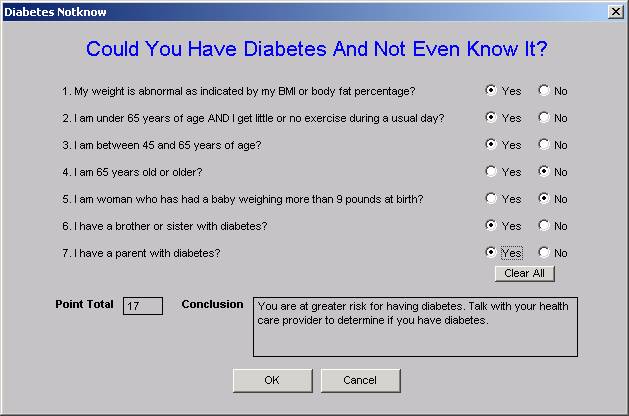
Reducing The Patient’s Risk
The following steps can help a patient reduce his/her risk of developing diabetes.
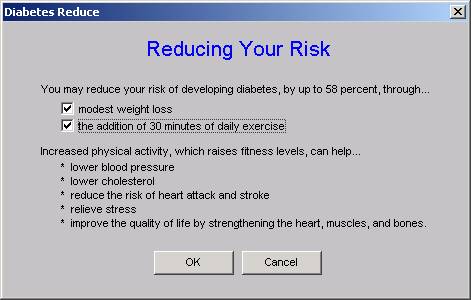
Low Risk of Developing Diabetes
The following characteristics, developed from a major study of nurses, are those of people with a very low risk of developing diabetes.

Summary
It is possible to live successfully with diabetes should a patient develop it; however, it is better for a patient to know their risk of developing diabetes and to take steps to delay or prevent its onset. SETMA is committed to:
- Excellent care of those with diabetes and
- Identifying those at increased risk of diabetes
- Identifying those who have pre-diabetes.
Our commitment extends to teaching the later two groups how to avoid or delay the onset of diabetes.
|